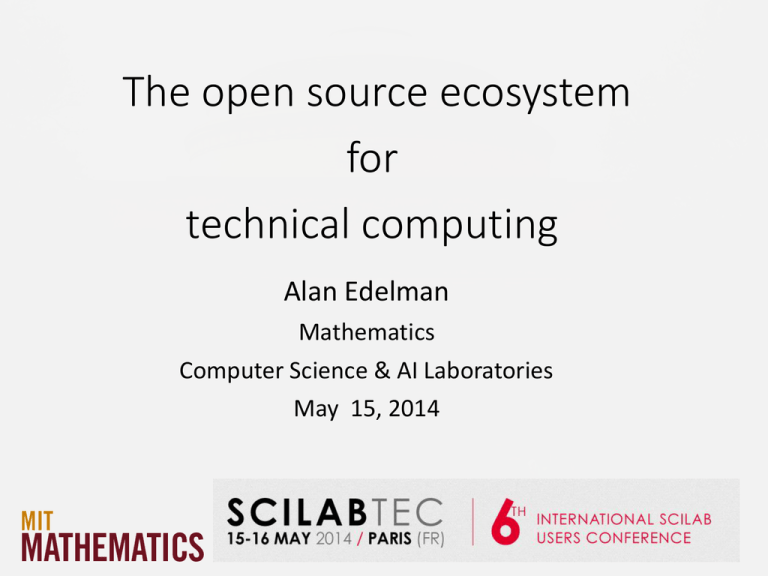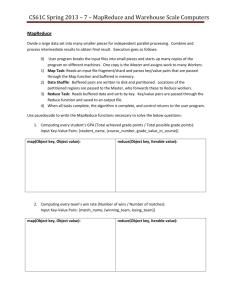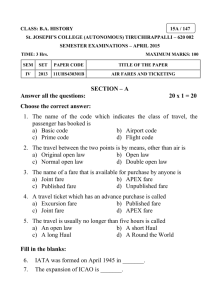The open source ecosystem for technical computing Alan Edelman
advertisement

The open source ecosystem for technical computing Alan Edelman Mathematics Computer Science & AI Laboratories May 15, 2014 How should octave Move technical computing forward? A vision of the future 2/30 The obvious… • High level technical computing languages traditionally • Consist of libraries of functionality • Packaged for user convenience • Open source or proprietary • We could all compete, or we could benefit from each other’s great work! 3/30 Some Examples 4/30 We used to talk about “consumer reports” • For numerical software • Especially optimization • 5/30 Ipython is wonderful! And not only just for python 6/30 From the Python World: MATPLOTLIB 7/30 Scilab calling Python 8/30 Moving Technical Computing Forward Goal: Bring Computer Science and Computational Science Together Stereotypes: Computer Scientists don’t take derivatives but computer scientists are great at abstractions Computational Scientists can’t declare types but computational scientists are great at simulations We want to bridge the gap between computer science and computational science 9/30 Living the life as a Computer Scientist, Computational Scientist, and Mathematician 10/30 Page 11 11/30 Page 12 12/30 Page 13 13/30 Page 14 14/30 Object-oriented programming with classes methods objects What can I do with/to a thing? buy top up pay fare lose buy top up pay fare lose class-based OO classes are more fundamental than methods buy pay fare lose 15 Object-oriented programming with multi-methods What can I do with/to a thing? buy top up pay fare multimethods relationships between objects and functions lose generic methods objects function 16 Multi-methods with type hierarchy buy top up rechargeable subway pass pay fare lose generic methods objects function single-use subway ticket subway ticket abstract object is a subtype of 17 Multi-methods with type hierarchy buy top up rechargeable subway pass pay fare lose generic methods objects function single-use subway ticket subway ticket abstract object is a subtype of 18 Multi-methods for linear algebra What can I do with/to a thing? find eigenvalues eigvals find eigenvalues and eigenvectors eigfact find singular values svdvals find singular values and vectors svdfact general matrix Matrix symmetric tridiagonal matrix SymTridiagonal bidiagonal matrix Bidiagonal generic methods objects function Methods can take advantage of special matrix structures 19 So how does this help us with linear algebra? 20 “Disconnected” Technical Computing World Desktop Productivity Cloud Potential Supercomputer Power 21/32 21/30 “Disconnected” Technical Computing World Desktop Productivity Easy on Humans Non-Expert Users Interface to vast libraries Desktop Performance Deep Chasm to cross Cloud Potential Supercomputer Power The Raw Power The Village The Market The Availability Hard on Humans Software 22/32 22/30 The “Two Language” Problem • As long as the developers’ language is harder than the users language, technical computing will always be hindered 23/30 Looking for Abstractions 24/30 Parallel Prefix 1,2,3,4,5,… 1,3,6,10,15,… 25/30 Iterative algorithms as iterators for item in iterable #body end #is equivalent to state = start(iterable) while !done(iterable, state) item, state = next(iterable, state) # body end 26 Conjugate gradients (Hestenes-Stiefel) state = start(iterable) done(iterable, state) Can we write this as an iterator? http://en.wikipedia.org/wiki/Conjugate_gradient_method 27 Conjugate gradients (Hestenes-Stiefel) state = start(iterable) state, dx = next(iterable, state) done(iterable, state) http://en.wikipedia.org/wiki/Conjugate_gradient_method 28 Hestenes-Stiefel CG immutable cg_hs #iterative solver K :: KrylovSpace #wraps A, v0, k t :: Terminator #termination criteria end immutable cg_hs_state r :: Vector #residual p :: Vector #search direction rnormsq :: Float64 #Squared norm of previous residual iter :: Int #iteration count end start(a::cg_hs) = cg_hs_state(a.K.v0, zeros(size(a.K.v0,1)), Inf, 0) function next(a::cg_hs, s::cg_hs_state) rnormsq = dot(s.r, s.r) p = s.r + (rnormsq/s.rnormsq)*s.p Ap = a.K.A*p α = rnormsq / dot(p, Ap) α*p, cg_hs_state(s.r-α*Ap, p, rnormsq, s.iter+1) end done(a::cg_hs, s::cg_hs_state) = done(a.t, s) K = method(KrylovSpace(A, b, k), Terminator()) x += reduce(+, K) # for dx in K; x += dx; end Abstracts out termination check and solution update steps 29 Conclusions… • Open source computing allows us to benefit from each other’s work • But Even More importantly • allows us to grow the very design base 30/30

